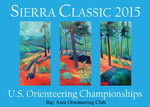O in the Oaks III 2-Day A-Meet
Date: Oct. 22 - 23, 2005
Location: San Jose, CA
Event Director: - 408.984.8124
Course Setters: Mattias Eriksson, Dean French
Type: A; 2-day combined-time "classic-distance" event
Course Setter's Notes
By Mattias Eriksson
The BAOC will hold the O' in the Oaks III, its annual Fall A-meet, at Joseph Grant County Park in San Jose, CA, on October 22-23rd. It will be a two-day, combined-time "classic-distance" event. Advanced and Intermediate courses will be on the Joe Grant North map, which was first used at last year's US Long Course Championship. This year's advanced courses have been set to feature technically difficult orienteering, including several complex route choices. We hope you will enjoy running through the pristine forest, taking in the stunning views, and solving the 15 square kilometer puzzle of Joe Grant North.
Courses
The courses will be very challenging, both technically (navigationally) and physically, and include, especially for the longer courses, several complex route choices. In some areas there will be clusters of controls somewhat close together. Be certain to check your control codes carefully.
Day 1: The intermediate and advanced courses on day 1 (Saturday) are, as you can see in the course statistics below, quite demanding physically. A great part of the climb, some of which is very steep, will be on the first third of the courses. Please be mentally prepared for a very tough beginning! The longer courses especially will also include considerable downhill running on the second half. The total climb you get can vary considerably depending on your route choices. The estimated values below should be regarded as guesses for how most people will run.
Course Distance Climb # of Controls
White 3.1 km 30 m 10 Yellow 3.3 km 130 m 13 Orange 4.3 km 230 m 14 Brown 3.4 km 190 m 9 Green 5.2 km 320 m 13 Red 7.3 km 450 m 13 Blue 8.7 km 500-550 m 18
Day 2: The courses on day 2 (Sunday) will (as compensation) be slightly easier physically. However, this does not mean that the courses will be easy. The Green, Red, and Blue courses still have considerable climb. Keep in mind also that you have a 2.5-km walk, including nearly 100-m climb, to the Start. The winning times on all intermediate and advanced courses will probably be considerably shorter on day 2 than on day 1. As on day 1, the total climb may vary a lot depending on your route choices.
Course Distance Climb # of Controls
White 3.0 km 120 m 12 Yellow 3.0 km 70 m 10 Orange 3.1 km 175 m 11 Brown 3.3 km 120 m 10 Green 5.0 km 270 m 11 Red 5.9 km 320 m 11 Blue 6.5 km 370 m 13
Note: Course information above is subject to change. Check the clue sheets printed on the maps for official information.
Climate
The climate in late October can be quite variable, ranging from sunny clear days with a high temperature of about 70 degrees, to cooler temperatures in the mid 40's. There is a slight chance of rain, but virtually no chance of snow.
Hazards
The biggest hazard will be the steep cliffs. They may be precarious and slippery. Be extremely careful! It is strongly recommended to wear real orienteering shoes with good grip on the Orange and advanced courses. It might be a good idea to consider avoiding the steepest areas when choosing routes.
Poison oak is very prevalent in some areas of the park. Poison oak will have mainly lost its leaves in October, and can be seen as a groundcover with short stems, about 1 foot high, vines, and occasional bushes. The stems and stalks still have the antigen that causes the rash. The best policy is to identify the plant, avoid it if possible, wear long pants and long-sleeve shirts, strip and wash off with Tecnu (available at most drug stores) right after the race and again when you get back to your hotel or home, and place your competition clothes (including shoes) in a plastic bag and do not touch them again until they have been washed. Use a high-strength topical steroid cream, e.g., Fluocinonide, 0.05%, as soon as you feel any itching or notice any small red bumps or lines on your skin, usually about 24 to 48 hours after exposure. If you use the topical steroid cream early, you can virtually eliminate any severe rash, but if you wait until after the rash has appeared, it takes much longer to get it under control.
Wild pigs are found throughout the park. These large gray mammals may travel in families and can be grumpy. They usually run away if you come close to them, but it is better not to mess with them and to go a different direction. Mountain lions, coyotes, and rattlesnakes live in the park, but spotting them this time of year would be rare. If you encounter any of these predators, walk slowly away (do not run).
All courses may cause you to pass across a number of barb-wired fences (all marked on the map). Once you are sure there is not a gate nearby, be careful to make sure not to hurt yourself or damage the fences when passing them. The best way to cross them is usually from below. Use your map/case to push up on the bottom strand of wire.
There is a large herd of cattle in a huge enclosed pasture in the south-western part of the park. You may encounter parts of it on the way to the start on day 1, or possibly at the last part of the advanced courses on day 1, but you might also not see them at all. Try to avoid them if possible, although they usually run away when you get close.

